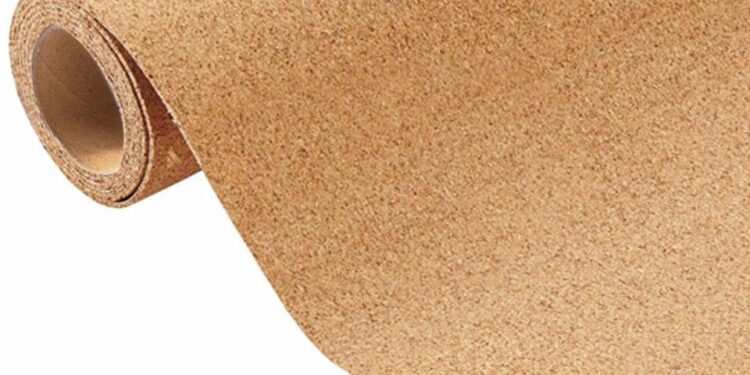As sustainability has gained more attention, eco-friendly methods and materials have permeated interior design. Undoubtedly, cork is becoming one of the most sustainable materials, natural and renewable, that has great environmental and aesthetic value. Eco-friendly Cork Roll is becoming popular for coverings, flooring, as well as furniture and other interior decorative features.
The cork expansion joint is made from clean, carefully selected granulated cork that has been glued with phenolic resin. It is extremely durable, compressing without extrusion and recovering to 95% of its initial width after 50% compression. A mid-structure split in building construction is called an expansion joint. Its purpose is to alleviate movement-induced pressure on building components. Thermal contraction and expansion as a result of temperature variations are primarily responsible for building movements at joints of expansion.
Cork rolls are extremely durable and long-lasting. A roll of cork can be useful as a silencing and insulating topcoat for panels, as well as an ornamental component for walls, which helps to insulate a space. Check out our extensive selection of cork rolls.
What Are Cork Rolls?
These rolls come in different grades of thickness and density; therefore, they are ideal for use as insulation and soundproofing materials, bulletin boards, and design finishes. Cork avoids all of the hazardous processes associated with other building materials.It is extracted in a manner that does not destroy the tree. Most importantly, bark striping is done in a manner that allows regeneration, enabling extraction every 9 to 12 years. Such methods, coupled with cork’s biodegradable features, make it a sustainable material for consumers and the designers.
Environmental Benefits of Cork Rolls
Renewable and Sustainable
One of the best ecological materials on the market right now is cork. The harvesting process involves stripping the bark off cork oak trees without destroying the trees. One tree can live for over two centuries and be harvested more than fifteen times. As a renewable resource, cork contributes to the conservation of ecosystems and biodiversity.
Carbon-Negative Material
Cork forests are vital in carbon sequestration, and, as some studies show, harvested cork trees absorb an increased amount of CO₂ in the period after being harvested, which makes the cork products carbon negative.
Recyclability and Biodegradable Properties
Cork, in contrast to synthetic substitutes, has elements that are both recyclable and biodegradable. In the concluding phase of its lifecycle, cork can biodegrade without emitting detrimental chemicals into the ecosystem. Furthermore, used cork can be replaced into new products, reducing waste in the process.
Sustainable Interior Design Projects Using Cork
Cork Rolls for Thermal and Acoustic Insulation
Roll of Cork for the wall provides excellent thermal and acoustic insulation qualities. Rows of cork are perfect for improving acoustics and energy efficiency indoors. Cork’s cellular structure holds millions of compartments that naturally absorb sound and retain heat. This makes cork rolls ideal whether placed on walls, ceilings, or under floors.
Covering Walls and Ceilings
Cork rolls can serve as a warm and textured ceiling and wall finish. West Corks provide interior spaces with a touch of natural appeal. Their texture provides visual interest while also reducing noise, making cork rolls ideal for studios, offices, and cozy living spaces.
Floor Coverings Underlayment
Cork expansion joints are often employed on a subfloor under hardwood, laminate, or tile floors as a supporting underlay. This makes the floors more comfortable to walk on, decreases the impact of noise, and provides additional thermal insulation. For some designers, thicker cork rolls are used as exposed floor surfaces for a sophisticated natural texture for a more distinctive look.
Ornamental as well as Functional Cork Furniture Pieces
Roll of cork design furniture goes from tabletops, chairs, and lamp bases to wall art. With its soft texture and warm tone, it’s no wonder cork is favored by minimalists and biophilic designers.
Cork works great with almost all styles: rustic, Scandinavian, modern, industrial, and more. Cork blends nicely with other natural materials, including wood, stone, and linen. It helps to add calmness and sophistication to any room, providing warmth and character. Cork roll does not disappoint the style either, being finished with natural oils, waxes, or even eco-friendly paints, without compromising sustainability.
Durability and Maintenance
Cork roll is one of the best choices when considering flooring materials, as it is quite durable despite its soft feel, as it resists wear, moisture, and insect damage with proper sealing. Maintenance is quite easy, as damp cloth and some dustings keep the surface looking fresh. In addition, the application of a natural sealant on cork in highly trafficked areas prolongs the material’s lifespan while keeping its eco-friendliness. Read This
Accessibility and Cost-effectiveness
Compared to other eco-friendly materials, cork roll for walls is quite affordable, and due to their multifunctionality, they can serve as insulation, wall panels, and soundproofing materials, which leads to cost savings due to being multifunctional. In addition, a growing market means that sustainable cork rolls are widely available in different styles and sizes.













